2015 Lincoln MKC First Drive

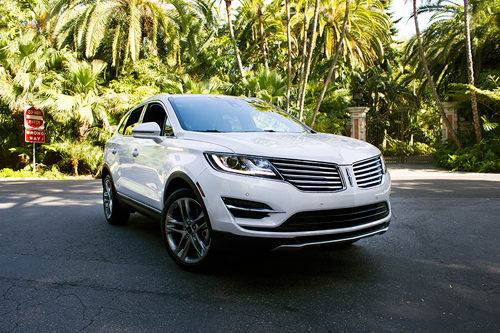
Cars.com’s team of editors at the 2013 Los Angeles Auto Show were convinced Lincoln’s compact luxury SUV, the MKC, had the right attitude to jump into the extremely competitive segment with a full head of steam; we unanimously named it a “Winner” in our auto show postmortem.
2013 L.A. Auto Show: Luxury Car Winners and Losers
Fast-forward a few months and I’m driving preproduction versions of the MKC in the Santa Barbara, Calif., area. Lincoln chose a peculiar selection of pavement for the introductory drive, consisting of high-speed canyon roads with countless tight turns, dips and elevation changes. It’s the kind of road motorcycles and sports cars call home, but not small SUVs. Did I mention this is a Lincoln? A brand that doesn’t have the most sporting reputation.
My chariot for most of the test was a loaded MKC with the optional and more-powerful turbocharged 285-horsepower, 2.3-liter four-cylinder engine, which comes standard with all-wheel drive. Perhaps the biggest surprise from this first romp in the MKC is that it’s not at all out of place being ferociously driven through winding California roads.
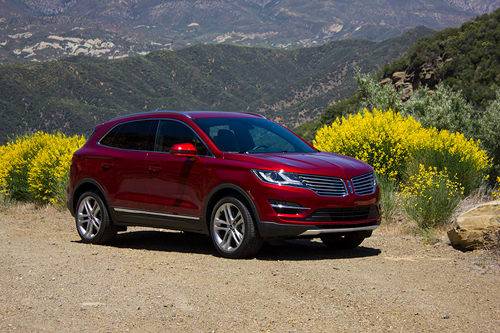
The MKC’s surprising agility is something almost all compact luxury SUVs promise; some deliver more than others. The competitive set includes the Acura RDX, BMW X1/X3, Land Rover Range Rover Evoque and Audi Q5. Few MKC owners will ever take their car on these canyon roads, but shoppers will be glad to know the MKC’s sporty promises are honored. The well-balanced MKC has significantly more cornering grip and handling confidence than you’d expect from a Lincoln SUV.
Best of all, ride quality on everyday roads is still luxury-like even with the MKC’s surprising dynamics. All-wheel-drive models use Lincoln’s continuously controlled dampening suspension to adjust shock firmness on the fly, and it works to a big extent. The SUV hunkers down in Sport mode and reduces body motion to almost nil compared to the comfy, isolated default mode.
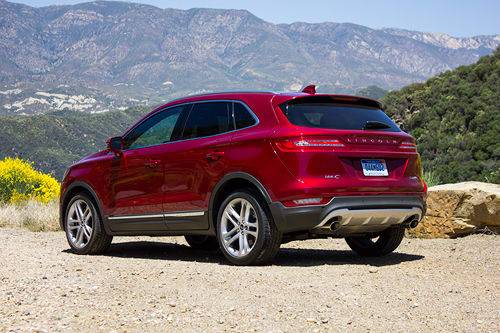
Luxury-like also describes the noise levels in various types of driving. Active noise cancellation and acoustic glass are a few ways Lincoln suppresses unwanted noises. There’s a slight whistle of wind noise at highway speeds. No worries, as the excellent and optional THX sound system can drown that out with ease.
Under the hood is equally quiet with both the more powerful engine I spent the most time driving, and the standard 240-hp, turbocharged 2.0-liter four-cylinder I took for a brief spin on different roads. The 2.3-liter is a unique engine not offered on the Ford Escape from which the MKC is derived, and is similar to the four-cylinder soon to be under the hood of the 2015 Ford Mustang. Power from the 2.3-liter is good; however, I wouldn’t call it particularly fun or a huge upgrade considering the 2.0-liter offers a similar punch despite being down 45 hp. Lincoln’s power ratings are measured using premium fuel, and regular can be used but won’t return the same power.
The 2.3-liter is currently offered in only the two higher trim levels, which puts its premium at over $4,000 versus the 2.0 all-wheel drive. It also has the lowest fuel economy of the bunch with 18/26/21 mpg city/highway/combined ratings and only comes with all-wheel drive. A front-wheel-drive 2.0-liter is rated at 20/29/23 mpg and with all-wheel drive is 19/26/22 mpg.
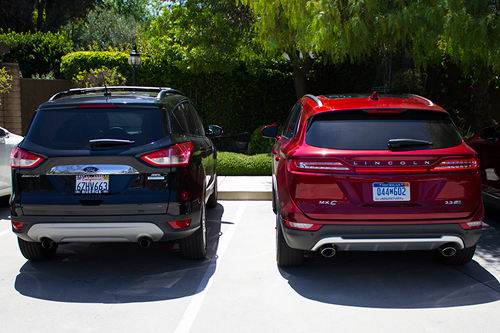
Lincoln’s design department should get a high-five for how well the MKC looks going down the road. Tight proportions, oozing style and a mean, aggressive stance are traits that breathe fresh air into the Lincoln brand. There’s little indication the MKC is based off Ford’s Escape platform — the MKC is sleeker and wider, and the contemporary exterior and interior are just as impressive now as they were on the auto show floor. It does all this without much sacrifice to interior room. At 6 feet tall, I sat comfortably in the backseat despite a sloping roofline that usually cuts into headroom.
So far, you’ve seen “optional” and “available” used frequently above, with good reason. Loaded with optional equipment like Bridge of Weir leather seating, 19-inch wheels, panoramic roof, navigation, blind spot warning, a Technology Package with adaptive cruise control and active park assist, power tilt/telescoping steering wheel, THX stereo and a lot more, the MKC I tested was a pricey $50,405 — the entry-level model starts at $33,995 (prices include destination).
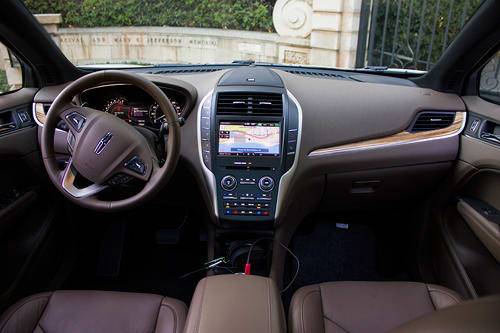
On the inside, Lincoln carries over the push-button gear selector from the MKZ. It’s there to free up space on the center console, and of course to be unique. In terms of usability difference compared to a traditional gear selector, there’s nothing groundbreaking with how the freed-up console space is used. There’s a small cubby with two USB ports and two cupholders — spaces easily found in other luxury SUVs that use a console shifter. I prefer the tactile feel of a traditional shifter compared to this button layout.
Lincoln sold roughly 600 MKCs so far in its first month on sale. Cars.com’s national inventory is quickly populating with the MKC and currently shows pricing favoring the $40,000-$45,000 spectrum. Lincoln offers a lot of flexibility with pricing and individual options, so it’s easy to customize to a price range. For $40,000-$45,000, the MKC should be a serious consideration for compact luxury SUV shoppers.

Managing Editor Joe Bruzek’s 22 years of automotive experience doesn’t count the lifelong obsession that started as a kid admiring his dad’s 1964 Chevrolet Corvette — and continues to this day. Joe’s been an automotive journalist with Cars.com for 16 years, writing shopper-focused car reviews, news and research content. As Managing Editor, one of his favorite areas of focus is helping shoppers understand electric cars and how to determine whether going electric is right for them. In his free time, Joe maintains a love-hate relationship with his 1998 Pontiac Firebird Trans Am that he wishes would fix itself. LinkedIn: https://www.linkedin.com/in/joe-bruzek-2699b41b/
Featured stories

15-Year Car Loans Aren’t a Thing, But Americans Are Getting More Comfortable With Long Loan Terms

2025 Kia Telluride Review: Rougher Roads Ahead



